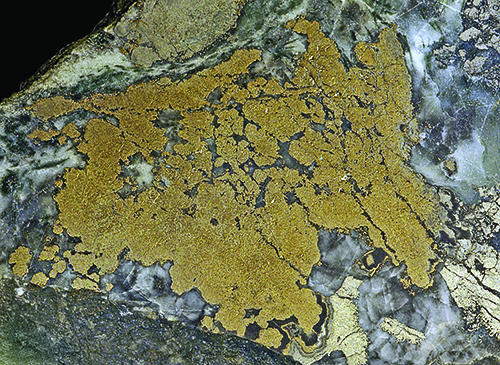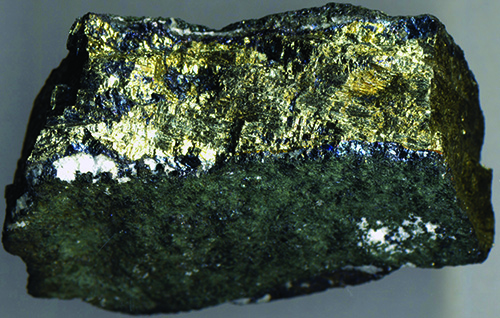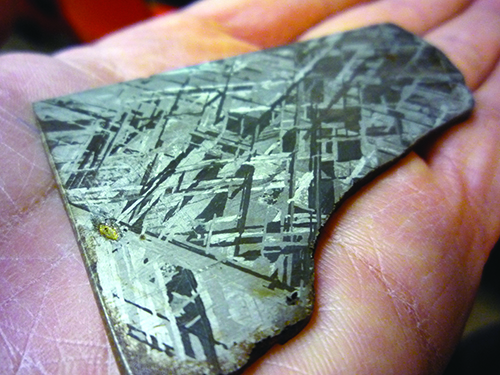
By Steve Voynick
The word “nickel” is a homonym with two distinct meanings. It refers to both our five-cent coin and an element. Everyone is familiar with the coin, but not necessarily with the element.
Pure nickel is a lustrous metal with a silvery-white color and a slight golden tinge. As a siderophilic element, it associates readily with iron and even shares some of iron’s properties. Its melting temperature, density, magnetic properties, and hardness are generally similar to those of iron. But iron oxidizes (rusts) readily, while nickel strongly resists oxidation.
Nickel is the Earth’s fifth most abundant element; most, however, is thought to be combined with iron in the Earth’s core. In crustal abundance, nickel ranks 28th among the elements and is about as common as copper. Native (elemental) nickel is rare in the crust but common in meteorites, mainly as the iron-nickel alloy taenite.
Tools and weapons of exceptional quality were fashioned from meteoritic taenite as early as 3500 BCE. By 1700 BCE, Chinese metallurgists were unknowingly using nickel in copper alloys.

Nickel’s modern story began when medieval miners in Germany’s Erzgebirge region found a reddish mineral that they erroneously believed contained copper. They blamed their inability to extract copper on nickel, an evil spirit of German mythology, who they thought had bedeviled the ore. The miners named the ore Kupfernickel, literally “copper devil,” from the German Kupfer, meaning “copper.”
In 1751, Swedish mineralogist Alex Fredrik Cronstedt smelted Kupfernickel to obtain a previously unknown metal that he named “nickel” after the mythical evil spirit. Today, Kupfernickel is the mineral nickeline (nickel-arsenide, NiAs) which has a coppery color and occurs in massive form.
Coinage was one of nickel’s first modern uses. Copper-nickel alloys appeared in U.S. coinage in 1858. In 1865, the U.S. Mint introduced a five-cent coin composed of a 75-25 copper-nickel alloy. That coin became known as the “nickel”—a name still used today.
By the 1880s, metallurgists learned to add small amounts of nickel to steel to improve corrosion-resistance, hardness, malleability, and high-temperature performance. Today, the production of stainless-steel, nickel-steel, and specialty alloys accounts for 86 percent of nickel demand.
Nickel is mined both from surface laterite and underground sulfide deposits. Laterite is a mix of iro nickeloxides and hydroxides and hydrous nickel silicates. The most abundant nickel-bearing mineral is pentlandite [iron-nickel sulfide, (Fe,Ni)9S8]; bronze-yellow with a metallic luster, pentlandite occurs in massive form. Another important nickel-ore mineral is millerite [nickel sulfide, NiS], which has a brassy-yellow color, an acicular habit, and usually occurs in radiating masses.
About 2.7 million tonnes of nickel are now mined worldwide each year, with Australia, Indonesia, Russia, South Africa, and Canada accounting for half of the global production. The United States has only one primary nickel mine. Although the nation also obtains nickel through recycling and as a by-product of base-metal and platinum mining, it imports most of its nickel requirements.
Refined nickel now sells for about $6.50 per pound.

About 4.2 million tonnes of nickel are used worldwide each year. Apart from alloys, nickel is also needed for electroplating solutions and the manufacture of magnets, rechargeable batteries, and industrial chemicals and catalysts.
Nickel mining and usage are at an all-time high. According to the Nickel Institute, a global association of nickel producers, 80 percent of all the nickel mined throughout history has been mined in just the last 30 years. Yet, there is no foreseeable nickel shortage. Current global ore reserves contain 300 million tonnes of nickel, which will last more than a century at the current rate of mining.
Although coinage is now only a minor use of nickel, the metal nevertheless makes up 25 percent of our nickels and 8.3 percent of our dimes, quarters, and half-dollars. And that’s the story of the nickel behind the nickel.
If you enjoyed what you’ve read here we invite you to consider signing up for the FREE Rock & Gem weekly newsletter. Learn more>>>
In addition, we invite you to consider subscribing to Rock & Gem magazine. The cost for a one-year U.S. subscription (12 issues) is $29.95. Learn more >>>
















